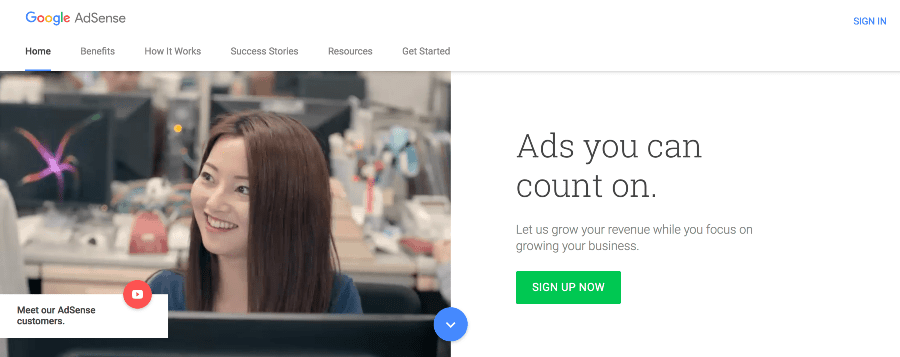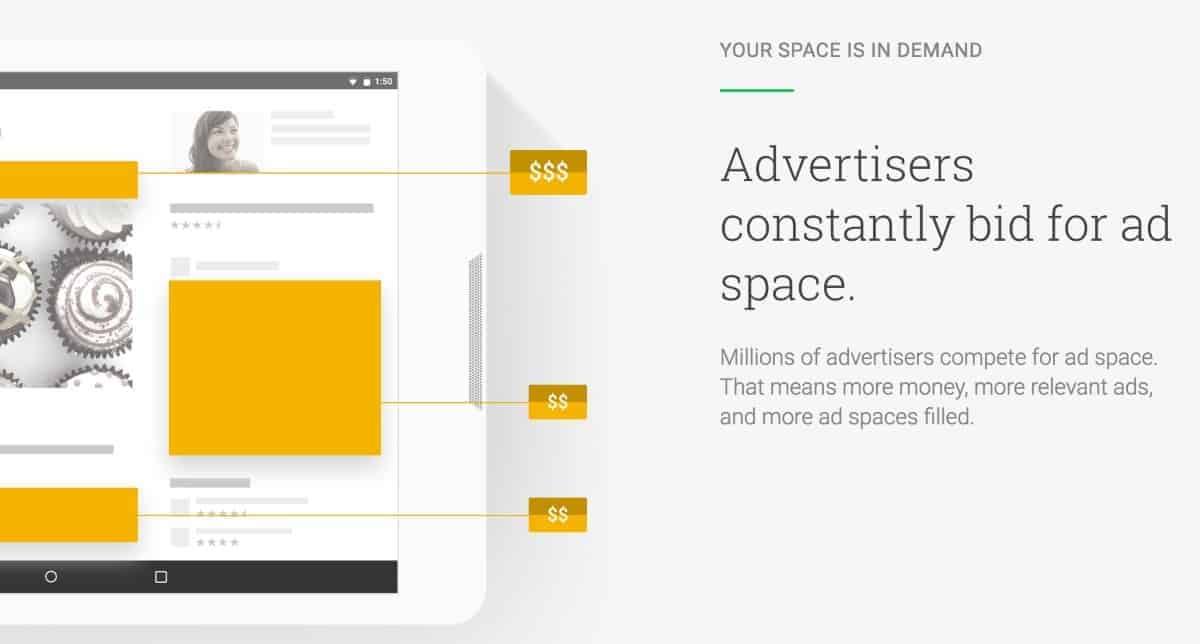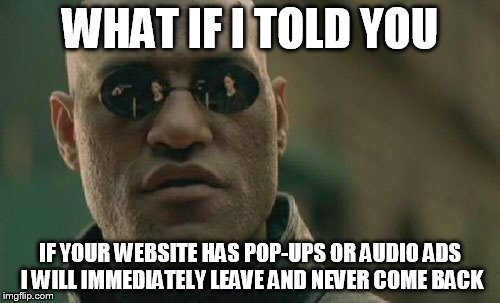We partner with bada$$ companies that offer products that help our readers achieve their goals! If you purchase through our partner links, we get paid for the referral at no additional cost to you! Read our disclosure for more info.
Looking to monetize your blog and wondering more about Google AdSense for blogs and whether it’s right for you? It could be depending on your blog and the type of content that you write.
So, you’ve started a blog, and now you’re ready to dive in and monetize it... If you’ve done any research at all, you’ve probably heard that ads are the best way to get started earning some money from your new blog.
Just slap a few ads up on the blog and watch that money start to roll in! That’s how it works, right?
You’ve probably also heard that Google AdSense for blogs is the best way to get started, but I’m here to tell you that it might not be…
Depending on your goals, blog content, and how long you’ve been blogging, AdSense may or may not be the right choice for you.
We want to give you a little more information to help you determine whether using Google’s popular ad platform on your blog is the right next step for you.
What is Google AdSense for blogs?
Google AdSense is a cost-per-click (CPC) advertising platform that allows publishers (i.e. bloggers) to insert a bit of HTML code into their sites to have ads appear — automatically targeted to be relevant to the site’s content.
Compared to some other ad platforms, it’s a pretty easy way for bloggers to get started making money from their site traffic.
Just add some code, let Google do all the heavy lifting, then watch the checks roll in!
Not so fast, folks.
While Google Adsense for blogs has several awesome benefits, it also comes with quite a few drawbacks and is therefore not always something that we recommend to new bloggers.
P.S. If you’re curious about how exactly AdSense works and read the nitty-gritty details, you can check out Google’s help page here.
Should I run Google AdSense on my blog?
I totally get the appeal of putting ads up on your blog!
Ads are great because they don’t require a ton of extra effort beyond the initial setup.
They are an incredibly passive source of blogging income and the other ways to monetize definitely require a lot more time and effort.
If you’re certain you want to monetize with ads, Google’s AdSense platform is definitely the easiest way to get started.
But as you may have begun to figure out… “Easiest” in the blogging world almost always comes with strings attached in the form of drawbacks (usually related to earnings!).
Ads, in general, require a LOT of traffic to generate a decent income and they also can make your blog look a bit tacky and/or unprofessional.
With that in mind, let’s go over some pros and cons of Google AdSense.
Google AdSense Pros
1. Easy to Implement
The deeper you go down the rabbit hole that is professional blogging, the more you’re going to come across a lot of technical stuff you won’t want to mess with.
While we think it’s really helpful to know a little bit about HTML and CSS to make simple edits to your blog without paying for help (and some other ins and outs of WordPress), we also don’t think that you need to spend your time learning much beyond that.
There are people out there that make their entire career out of writing code and connecting technical pieces of websites together. You can hire people quickly and easily on sites like Upwork if you’re ever in need of that kind of help.
Now, for some good news…
If you’re not the kind of person that wants to mess with any of that or don’t know how to, you don’t actually need it to set up AdSense!
Adsense is one of the easiest platforms to add to your website, which makes it great for beginners who want to experiment with using ad networks on their blogs.
2. Set It And Forget It
As a blogger, you have a lot to work on at any given time of the early growth phases, and you should be spending most of your time creating awesome content – not pitching, negotiating, and collecting money from advertisers (let alone learning how to do all those things).

The AdSense platform eliminates a lot of that hassle. You can basically just add the code to your site and forget about it and let Google take care of the rest.
3. No Minimum Traffic Levels
Most premium ad networks for bloggers pay more and therefore are more stringent with who they accept in their network.
They implement “minimum traffic levels,” which means that you have to have a certain level of traffic on your blog before you can be accepted.
For example, our top recommendation for a premium ad network to get started with is Ezoic, and they require 10,000 sessions in 30 days.
Google AdSense doesn’t have any such requirements, so you can start earning your first few bucks right away – even if you only have a few hundred monthly visitors to your site.
Looking to get more visitors to your site?
Here are a couple of our best resources for increasing your SEO traffic:
4. Obscure topics are welcome.
Some bloggers are really passionate about a small, highly targeted niche (we love you, upside-down underwater basket weavers!).
We also once heard of a guy making six figures from his blog selling board games about herbs…
While we admire chasing your crazy, seemingly obscure passions, it isn’t always ideal for turning your blog into a money-making machine.
It’s definitely something to consider when you’re thinking about monetizing, but thanks to Google AdSense’s sheer size of advertiser base, you can often find targeted ads for even the most obscure topics.
5. It’s easy for advertisers to target your blog.
AdSense places ads on your blog in a couple of ways.
Usually, they look at your content and then display ads based on the topics that they believe relate to your content to maximize your (and their) chances of earning money.
But they also allow advertisers to specifically target your blog, without the above matching up of topics.

This is actually great because if the ad does well, that advertiser might reach out to you personally to grow the relationship with private ad deals, sponsorships, affiliate programs, and more.
Keep in mind that you would need a lot of traffic for the advertiser to reach out for any kind of partnership.
6. Google AdSense offers multiple ad formats.
Compared to other ad platforms, AdSense generally has a larger variety of ad sizes and formats to make ads work for your blog without seriously wrecking the overall look of your blog.
Google not only offers a bunch of ad sizes to choose from here, but you can also choose from a ton of ad formats including:
- Text ads, image ads,
- Video ads,
- Search ads (if you use their search bar on your site),
- “Matched content” (where they add those “related articles” links after a post),
- And “link units” (which ad links to pages of ads related to topics on your site).
So when it comes to ads, AdSense is pretty much a one-stop shop.
But… As we said before, easier is not always better.
A tradeoff to be aware of when it comes to ads is that the more you have on your blog, the higher your earnings will be, but the worse off your blog will look because of it.
Speaking of downsides… Let’s move on to some of the drawbacks of Google Adsense.
Google AdSense Cons
1. Google Adsense for blogs doesn’t pay much in the short term.
You’ve just started and you’ve already forked over a few pretty pennies for hosting, a good blog theme, maybe email marketing, and a few other costs to getting started.
At this point, you’re probably starting to get anxious (and not in a good way) about when you’re going to start making money to cover some of these expenses.
So let’s talk blog monetization for a minute.
No matter what path to monetization you choose, it’s going to take some real time and effort to make some serious money, and ad revenue is, unfortunately, one of the slowest paths to a six-figure blogging income.
Here’s a quick example to illustrate this fact:
- Google AdSense pays you for each click ads generate on your site.
- The average click-through rate (CTR) for ads varies by industry, topic, how you display the ads, and more, but the average is around 0.1% of traffic.
- Then let’s say you can earn a cost-per-click (CPC) of $0.75 from your AdSense ads.
That means you’ll need around 1,000 unique visitors a day to earn just $0.75.
Yikes.
Here’s the thing: If you’re kick-ass enough to build your blog to that many visitors, you can definitely do better than that.
This is why waiting until you reach 10k sessions and starting with Ezoic might be the best plan.
2. Ads are distracting for your readers.

As a blogger, you’re in a constant struggle for new and better ways to catch and hold your reader’s attention with content.
It’s hard enough to do this without having to compete against yourself with ads.
While you’re working hard to write attention-grabbing introductions and helpful, information-packed posts, the ads on your site are doing everything they can to pull your reader’s attention away from your content to get clicks for themselves.
Not only are the ads distracting for your readers, but you also have to spend the time to test, monitor, and manage your ads if you want to earn more money with them.
All that translates to a lot of time and attention that can be put to better use elsewhere like content creation, driving traffic, or other methods of monetization.
3. AdSense ads can lower conversions.
Did you know that 53% of mobile users (who do most of the web browsing these days) will leave any website that takes longer than 3 seconds to load?
It’s true, according to Google itself.
There are a lot of factors that go into how fast or slow your site is to load but one thing is clear: ads will slow down your website.
If ads are slowing down your site, your readers will bounce and never get a chance to convert on any offer you might make them (i.e. sign up for your email list, comment, read another article, purchase a product, etc.).
And even if you’re site does load, you have to consider the design and look of your site.
94% of people say that bad design is a reason why they don’t trust some sites and having a bunch of ads close to the top of the page (where they’re most likely to get clicks) is a great way to turn readers away right from the start.

Between the website speed and the primary objective to get readers OFF of your site, ads can have a serious impact on your conversions.
4. AdSense ads can undermine your goals.
Remember that as a blogger and a content creator, your biggest goal should be to provide value to your readers.
Yes, you need to make some money too, but you achieve the monetary goal and all others by always striving to achieve the value goal above.
While you could argue that a perfectly placed ad might provide value to your readers by offering them something they really want, right when they want it, many ads simply won’t be relevant to them (despite Google’s best efforts).
Even if an ad could offer something relevant and valuable to your readers, you could do the same thing yourself and make a lot more money doing it using things like affiliate marketing and creating courses.
And at the end of the day, the whole point of an ad is to get readers to click the ad and leave your site, which makes it harder to build a relationship with them and impossible to offer them other, more valuable resources.
On top of that:
5. You’ll have to give up some control over the content.
For many of you who are really passionate about what you do and what you write, your blog will be like your baby and you’ll work hard to build it up. You’re totally in control of the content you create and the look and feel of your website.
That’s something you’ll have to compromise to some degree when it comes to ads.
At a high level, if your goal is to generate money from ads, you’ll naturally start to gravitate toward content that’s more likely to create profitable ad clicks.
Plus, you’ll have no control over how each ad looks, what the ad copy says, or where the ad goes.
And you’ll have to abide by Google’s AdSense Terms and conditions, which aren’t anything too crazy but do put some limits on you if you want to keep earning income from them.
6. AdSense ads can slow your audience growth.
Fact: When new visitors reach your blog and see ads, they’ll often immediately feel like you’re trying to sell them something.
Unfortunately, this can break a reader’s trust before you’ve gotten a chance to even get the relationship started.
Ads are like constantly having a sales pitch on your blog and that makes it harder to build trust with new readers and get them to take those precious call-to-actions that we discussed previously (email sign-ups, product purchases, etc.).
7. Your reputation may take a hit.
There are a ton of different products and companies that will be advertising on YOUR blog, and you won’t have much control over it. Some products could be less-than-stellar or even products that you would recommend against.
With Google AdSense for blogs, you’re rolling the dice. One day you might have an advertiser you totally love and would recommend anyway, and the next, you might have an ad for a product you absolutely hate.
The problem here is that your readers are going to associate YOU with the products that are advertised on your site, whether you would actually recommend them or not.
As a blogger, you know that those ads are chosen by Google’s algorithm, but most people don’t know that and will assume you endorse any ads on your site to some degree.
This means your reputation could take a hit any time that a shady supplement company’s ad shows up next to your content.
What are some other ways can I monetize my website?
Okay, guys… With the pros and cons of Google AdSense out of the way here’s our professional opinion:
AdSense ads are fine, but you shouldn’t expect them to be your primary source of revenue, especially when you’re just getting started.
Bottom Line: The income potential just isn’t there, and what little you can make while you’re growing isn’t worth the costs in attention and trust-building.
If you want to make great money, adding ads is one of the last things you should do to monetize (when you have enough traffic to work with a premium ad network like Ezoic.
This is the ad network that we used, and we didn’t start using them until over a year after we started our health and wellness blog and were already making a consistent $10,000 – $20,000/month with it.
How did we start making $10-20k/month with our blog?
We outline the steps in our comprehensive guide on How to Make Money Blogging!
If you enjoyed this article on Google Adsense for blogs or have any questions for us, please leave them in the comment section below. We’d love to hear from you!